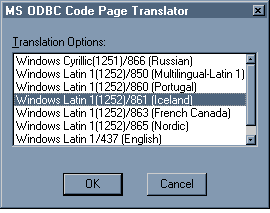Character Translation
Applications and data sources often contain data stored in different character formats. The BASIS ODBC Driver provides the capability to define an ODBC translator and code page to reconcile the character formats, and recommends using the Microsoft Code Page Translator for this task, as follows:
-
In the BASIS ODBC Driver Data Source Configuration dialog, click [Translate] to display the Select Translator dialog.

-
The Select Translator dialog displays a list of translators installed on the system. Select MS Code Page Translator and click OK to display the MS Code Page Translator dialog.

-
Select the desired code page and click OK.
-
As part of the connection process, the BASIS ODBC Driver loads the selected translation DLL, which is used to translate all data sent from the BASIS ODBC Driver to the application. All data written to the data source physical files will be translated back into the original character set.
-
It is possible to make customized conversion tables in ASCII files that are saved with .cpx extensions to the windows/system directory.
The following table is an example of the ISO 21 character set that converts between 7-bit German characters and the Windows Latin character sets:[Windows Latin 1 (1250)/ ISO21 beide]
124:246
92:214
123:228
91:196
125:252
93:220
126:223
/
246:124
214:92
228:123
196:91
252:125
220:93
223:126The following table is an example of the ISO 10 character set that converts between 7-bit Swedish characters and the Windows Latin character sets:
[Windows Latin 1 (1252) / ISO 10 (Swedish)]
91:196
92:214
93:197
123:228
124:246
125:229
94:220
126:252
/
196:91
214:92
197:93
228:123
246:124
229:125
220:94
252:126